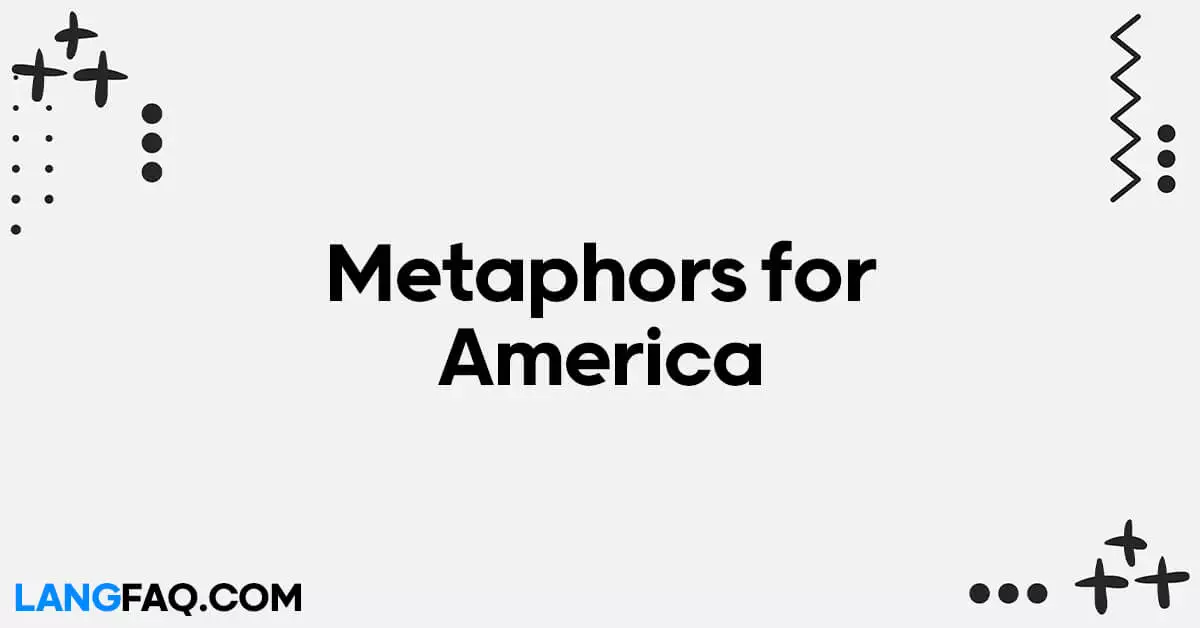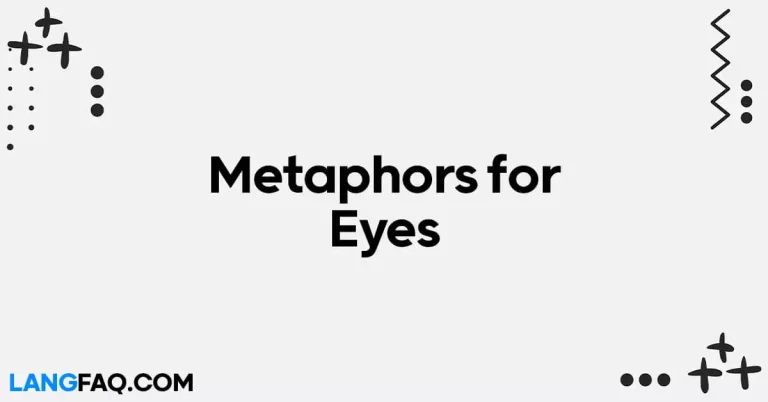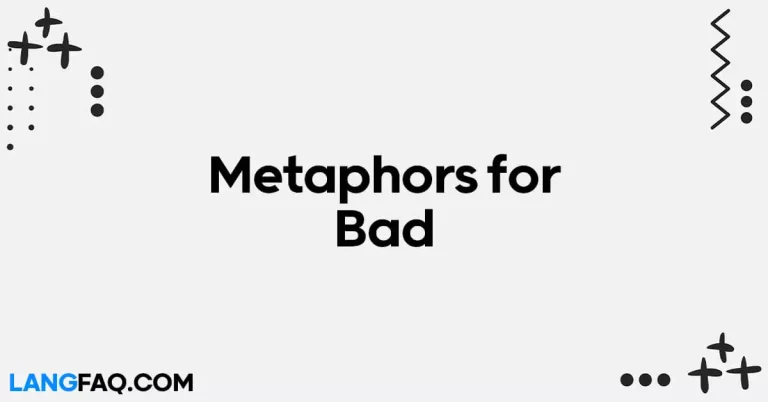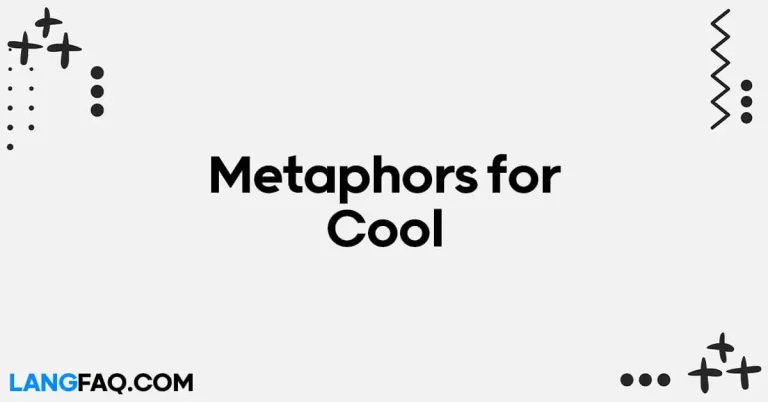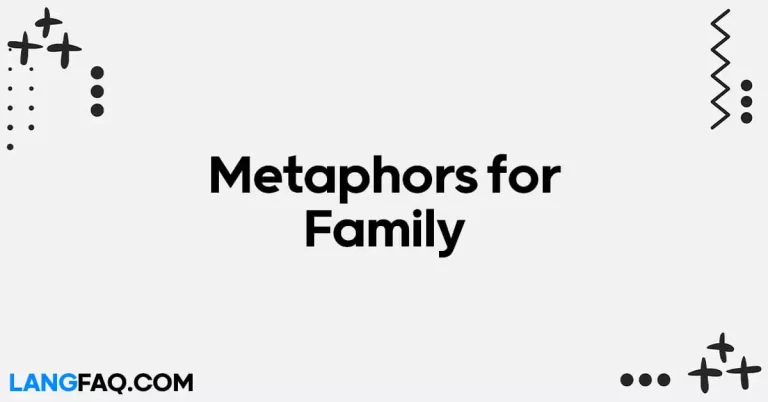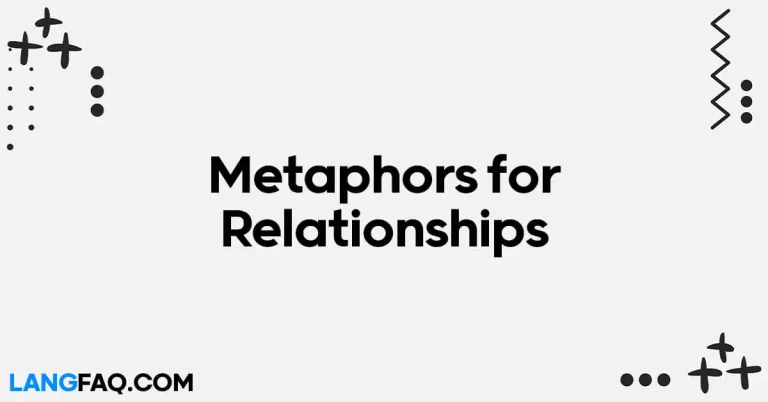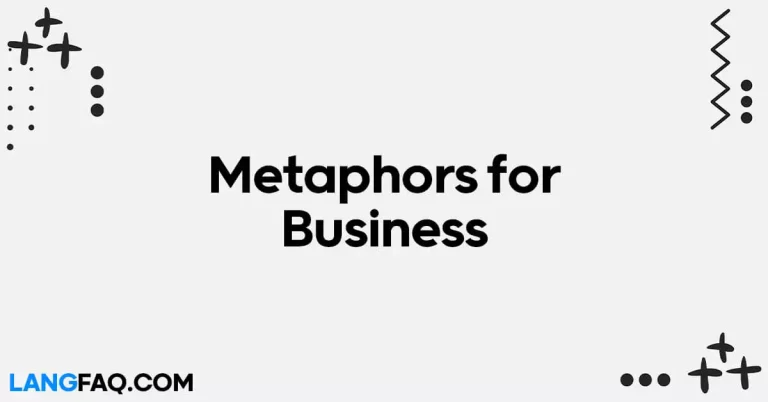America, a land of diverse cultures and histories, is often depicted through metaphors that encapsulate its identity. In this exploration, we delve into the intricate web of symbols and narratives that metaphorically paint the portrait of the United States.
In exploring the kaleidoscope of “Metaphors for America,” we embark on a journey through the linguistic landscape that defines the nation. From the majestic purple mountains to the bustling Silicon Valley, these metaphors encapsulate the spirit of a nation that thrives on innovation, cherishes its history, and celebrates the harmonious blend of cultures that form its cultural mosaic.
26 Metaphors for America
- The Melting Pot: Reflecting the diverse amalgamation of cultures and backgrounds.
- The Land of Opportunity: Symbolizing the promise of success and prosperity for all.
- The American Dream: Conveying the pursuit of individual happiness and achievement.
- The Beacon of Freedom: Describing America’s role as a guiding light for democratic values.
- The Founding Fathers’ Legacy: Representing the enduring influence of the nation’s founders.
- The Bald Eagle: Signifying strength, majesty, and resilience.
- Lady Liberty: Embodies freedom, justice, and the spirit of democracy.
- Manifest Destiny: Describing the historical belief in westward expansion and destiny.
- The Great Melting Pot: Echoing a unity formed by diverse cultures and backgrounds.
- The Land of the Free: Expressing the liberty and freedom enjoyed by citizens.
- The Shining City on a Hill: Reflecting a beacon of moral and social leadership.
- The Heartland: Symbolizing the cultural and agricultural core of the country.
- The Breadbasket: Describing the central region’s role in food production.
- The New Frontier: Representing continual opportunities for progress and growth.
- The Global Policeman: Signifying America’s role in maintaining international peace.
- The Cultural Mosaic: Depicting a nation rich in varied arts, customs, and traditions.
- The Arsenal of Democracy: Reflecting America’s industrial and military might.
- The Red, White, and Blue: Symbolizing patriotism and national identity.
- The Sleeping Giant: Describing America’s potential for great power and influence.
- The Land of the Brave: Emphasizing courage and resilience in the face of challenges.
- The City on the Move: Portraying the dynamic and progressive nature of urban centers.
- The Silicon Valley: Signifying innovation and technological advancement.
- The Wall Street Titan: Representing financial power and economic influence.
- The Ivy-Covered Halls: Describing esteemed academic institutions and knowledge.
- The Purple Mountains Majesty: Referring to the scenic grandeur of the country.
- The Home of the Free Thinkers: Embracing a culture of diverse thoughts and ideas.
| Metaphor | Meaning | Examples |
|---|---|---|
| The Melting Pot | Diverse cultures merging into one harmonious whole | The United States is often described as a cultural melting pot. |
| The Land of Opportunity | Promise of success and prosperity for all | Immigrants come to America seeking the land of opportunity. |
| The American Dream | Pursuit of individual happiness and achievement | Many believe homeownership is a key part of the American Dream. |
| The Beacon of Freedom | Guiding light for democratic values | The Statue of Liberty stands as a beacon of freedom in the harbor. |
| The Founding Fathers’ Legacy | Enduring influence of the nation’s founders | The Constitution is a testament to the Founding Fathers’ legacy. |
| The Bald Eagle | Symbol of strength, majesty, and resilience | The bald eagle is an iconic representation of American ideals. |
| Lady Liberty | Embodiment of freedom, justice, and democracy | Lady Liberty’s torch symbolizes the flame of freedom. |
| Manifest Destiny | Historical belief in westward expansion | The Oregon Trail is a manifestation of the concept of Manifest Destiny. |
| The Great Melting Pot | Unity formed by diverse cultures and backgrounds | The cultural diversity in New York City is a great melting pot. |
| The Land of the Free | Expression of liberty and freedom | The national anthem proudly declares America as the land of the free. |
| The Shining City on a Hill | Beacon of moral and social leadership | The United States sees itself as a shining city on a hill for democracy. |
| The Heartland | Cultural and agricultural core of the country | The Midwest is often referred to as America’s heartland. |
| The Breadbasket | Central region’s role in food production | The Midwest serves as the breadbasket of the nation. |
| The New Frontier | Continual opportunities for progress and growth | The space race in the 1960s represented a new frontier for America. |
| The Global Policeman | Role in maintaining international peace | The United States acts as a global policeman in times of conflict. |
| The Cultural Mosaic | Richness in varied arts, customs, and traditions | The cultural mosaic of America is evident in its festivals. |
| The Arsenal of Democracy | Industrial and military might | During World War II, America was often referred to as the arsenal of democracy. |
| The Red, White, and Blue | Symbol of patriotism and national identity | The American flag is a representation of the red, white, and blue. |
| The Sleeping Giant | Potential for great power and influence | When awakened, the United States is a sleeping giant in global affairs. |
| The Land of the Brave | Emphasis on courage and resilience | The national anthem celebrates the land of the free and the home of the brave. |
| The City on the Move | Dynamic and progressive nature of urban centers | New York City is often described as a city that never sleeps, always on the move. |
| The Silicon Valley | Signifying innovation and technological advancement | Silicon Valley is the epitome of the nation’s technological prowess. |
| The Wall Street Titan | Representing financial power and economic influence | Wall Street is a titan in the world of finance. |
| The Ivy-Covered Halls | Esteemed academic institutions and knowledge | The Ivy League universities are known for their ivy-covered halls. |
| The Purple Mountains Majesty | Scenic grandeur of the country | The Rocky Mountains exemplify the purple mountains’ majesty. |
| The Home of the Free Thinkers | Embracing a culture of diverse thoughts and ideas | America has always been a home for free thinkers and innovators. |
The table, rich with metaphors for America, unveils a narrative of diversity, resilience, and innovation. Each entry intricately contributes to the tapestry that defines the nation’s enduring spirit.
The Melting Pot: Embracing Diversity in Unity
In the vast tapestry of American culture, the metaphorical concept of the “Melting Pot” stands as a testament to the nation’s ability to blend diverse cultures into a harmonious whole. This metaphor captures the idea that immigrants from various backgrounds come together, contributing their unique flavors to create a richer, more vibrant society.
When to Use:
- Formal: In professional settings, this metaphor can be used to highlight the strength of a diverse team and its ability to collaborate effectively.
- Informal: Among friends or in casual conversations, it can express the beauty of different cultures converging in a community.
Example: Email Sample: Subject: Celebrating Diversity in Our Team
Dear Team,
As we embark on new projects, let’s remember that our strength lies in our diversity. Together, we form a powerful melting pot of ideas and perspectives that drive innovation.
Best regards, [Your Name]
Grammar/Usage Tip: Ensure that the metaphor fits the context. In academic or serious business discussions, avoid overly colloquial usage.
The Land of Opportunity: A Promise for All
In the lexicon of American metaphors, “The Land of Opportunity” encapsulates the promise that the United States holds for success and prosperity, irrespective of one’s background. It conveys the belief that anyone can achieve their goals with hard work and dedication.
When to Use:
- Formal: In a professional context, this phrase is apt when discussing career growth and possibilities within a company.
- Informal: Among friends, it’s a motivational phrase to encourage pursuing dreams and aspirations.
Example: Dialogue Snippet: Friend 1: “I’m thinking of starting my own business.” Friend 2: “Absolutely! America is the land of opportunity. Go for it!”
Grammar/Usage Tip: Use the phrase judiciously, especially in situations where systemic barriers may be acknowledged to maintain sensitivity.
The American Dream: Pursuing Individual Happiness
In the grand narrative of America, the metaphorical concept of the “American Dream” embodies the pursuit of individual happiness and success. This powerful metaphor has fueled the aspirations of millions, emphasizing that with determination, one can achieve personal fulfillment.
When to Use:
- Formal: Ideal for speeches or presentations, especially in contexts related to success stories and personal achievements.
- Informal: In personal conversations, it can motivate others to strive for their dreams.
Example: Presentation Excerpt: “In our organization, we believe in fostering an environment where every employee can pursue their version of the American Dream—personal and professional success hand in hand.”
Grammar/Usage Tip: While commonly used, ensure its relevance in contexts where individual success is the central theme.
The Beacon of Freedom: Guiding Light for Democracy
In the symphony of American metaphors, “The Beacon of Freedom” shines as a guiding light, symbolizing the principles of democracy. This metaphor suggests that the United States serves as a luminary example, illuminating the path towards liberty, equality, and justice.
When to Use:
- Formal: Perfect for diplomatic discussions, emphasizing the nation’s commitment to democratic values.
- Informal: In discussions among friends or community gatherings, it can evoke pride in democratic ideals.
Example: Community Gathering Speech: “As we celebrate our nation’s history, let us remember that we are a beacon of freedom, inspiring others around the world to strive for democracy and human rights.”
Grammar/Usage Tip: Use this metaphor judiciously to avoid sounding overly patriotic in contexts where a neutral tone is required.
The Founding Fathers’ Legacy: Enduring Influence
Woven into the fabric of America, the metaphor of “The Founding Fathers’ Legacy” represents more than historical figures; it embodies the enduring ideals and principles that shape the nation’s foundation.
When to Use:
- Formal: In academic or historical discussions, highlighting the ongoing impact of the Founding Fathers’ principles.
- Informal: Among patriots or history enthusiasts, expressing admiration for the nation’s foundational thinkers.
Example: Email Sample: Subject: Our Founding Principles
Dear Team,
In times of challenge, let’s reflect on the wisdom of our Founding Fathers. Their legacy remains a guiding force in our pursuit of a more perfect union.
Sincerely, [Your Name]
Grammar/Usage Tip: In formal writing, ensure accuracy when referencing specific Founding Fathers and their contributions.
The Bald Eagle: Symbol of Strength and Majesty
Soaring above the American landscape, the metaphor of “The Bald Eagle” symbolizes strength, majesty, and resilience. This iconic bird is more than a national symbol; it embodies the ideals of a powerful and enduring nation.
When to Use:
- Formal: In discussions about national symbols or during patriotic events, emphasizing strength and resilience.
- Informal: Among nature enthusiasts or in casual conversations, expressing admiration for the nation’s symbols.
Example: Dialogue Snippet: Colleague 1: “Our quarterly report wasn’t what we expected.” Colleague 2: “No worries; we’ll rise above it, like the bald eagle facing a storm.”
Grammar/Usage Tip: When using animal metaphors, be cautious of appropriateness in various cultural contexts.
Lady Liberty: Embodiment of Freedom, Justice, and Democracy
Standing tall in New York Harbor, “Lady Liberty” is not merely a statue; she is a metaphorical embodiment of freedom, justice, and the democratic spirit. Her torch illuminates the principles that form the cornerstone of the American identity.
When to Use:
- Formal: During discussions about democratic values or in political contexts, emphasizing the enduring symbolism of Lady Liberty.
- Informal: In conversations about national pride or shared values, celebrating the iconic stature of Lady Liberty.
Example: Political Address Excerpt: “As we face challenges, let us draw inspiration from Lady Liberty, a symbol of the enduring spirit of democracy and justice that defines our nation.”
Grammar/Usage Tip: Ensure accuracy when using this metaphor, emphasizing its cultural and historical significance.
Manifest Destiny: Historical Belief in Westward Expansion
In the historical tapestry of America, the metaphor of “Manifest Destiny” represents the 19th-century belief that westward expansion was not only justified but inevitable. This metaphor encapsulates the spirit that drove the nation’s territorial growth.
When to Use:
- Formal: In historical analyses or academic discussions, exploring the impact of Manifest Destiny on American history.
- Informal: In casual conversations about the nation’s past, acknowledging the complexities of westward expansion.
Example: History Lecture Excerpt: “Manifest Destiny was a driving force in shaping our nation’s borders, but we must also recognize its implications on indigenous communities.”
Grammar/Usage Tip: When discussing historical events, ensure a nuanced approach, acknowledging diverse perspectives.
The Great Melting Pot: Unity Formed by Diverse Cultures
In the mosaic of American culture, the metaphor of “The Great Melting Pot” signifies unity formed by diverse cultures and backgrounds. This metaphor celebrates the harmonious blend of traditions, languages, and customs.
When to Use:
- Formal: In multicultural settings or discussions on diversity and inclusion, highlighting the strength of a unified culture.
- Informal: Among friends or in community gatherings, expressing appreciation for the richness of diverse backgrounds.
Example: Community Event Speech: “As we celebrate our diverse community, let us remember that we are a great melting pot, where every individual contributes to our shared cultural tapestry.”
Grammar/Usage Tip: Be mindful of cultural sensitivity, ensuring that the metaphor is used inclusively.
The Land of the Free: Embracing Liberty and Freedom
In the lexicon of American metaphors, “The Land of the Free” encapsulates the essence of liberty and freedom enjoyed by citizens. This metaphor celebrates the fundamental rights that define the American spirit.
When to Use:
- Formal: Ideal for speeches or discussions on civil liberties and constitutional rights, emphasizing the nation’s commitment to freedom.
- Informal: In casual conversations or patriotic events, expressing pride in the freedom enjoyed by citizens.
Example: Patriotic Event Toast: “As we raise our glasses, let’s celebrate the land of the free, where our rights are not just protected but cherished.”
Grammar/Usage Tip: Ensure the metaphor aligns with the tone of the discussion, avoiding overuse in contexts requiring a neutral stance.
The Shining City on a Hill: Exemplifying Moral and Social Leadership
In the mosaic of American metaphors, “The Shining City on a Hill” stands as a metaphorical beacon exemplifying moral and social leadership. This phrase, often used in political discourse, portrays America as a model for others to follow.
When to Use:
- Formal: In political speeches or discussions on international relations, highlighting the nation’s commitment to moral leadership.
- Informal: Among community leaders or in discussions about societal values, expressing the aspiration to be a shining example.
Example: International Relations Address Excerpt: “As a nation, we strive to be a shining city on a hill, inspiring others towards justice, equality, and compassion.”
Grammar/Usage Tip: Use this metaphor judiciously, ensuring that it aligns with the actions and policies being discussed.
The Heartland: Cultural and Agricultural Core
In the metaphorical landscape of America, “The Heartland” symbolizes the cultural and agricultural core of the country. This phrase paints a vivid picture of the regions that are central to the nation’s identity.
When to Use:
- Formal: In economic discussions or agricultural analyses, emphasizing the significance of the heartland to the nation’s well-being.
- Informal: Among friends or in discussions about regional identity, expressing pride in the heartland’s contributions.
Example: Agricultural Symposium Keynote: “The heartland of America sustains not only our crops but also our cultural roots, fostering a deep connection to the land.”
Grammar/Usage Tip: Ensure clarity in usage, especially when discussing both cultural and agricultural aspects.
The Breadbasket: Central Region’s Role in Food Production
In the metaphorical lexicon of America, “The Breadbasket” highlights the central region’s pivotal role in food production. This phrase acknowledges the agricultural prowess that sustains the nation.
When to Use:
- Formal: In agricultural discussions or policy contexts, emphasizing the importance of the breadbasket to national food security.
- Informal: Among food enthusiasts or in casual conversations, expressing appreciation for the heartland’s contribution to the nation’s table.
Example: Policy Brief Excerpt: “As we formulate agricultural policies, we must recognize the vital role of the breadbasket in ensuring a stable and secure food supply for the nation.”
Grammar/Usage Tip: Be specific about the region referred to as the breadbasket, considering variations in agricultural importance.
The New Frontier: Continual Opportunities for Progress
In the narrative of American metaphors, “The New Frontier” signifies continual opportunities for progress and growth. Coined during the Kennedy era, this metaphor has endured, representing the unexplored territories of innovation and development.
When to Use:
- Formal: In business presentations or discussions on technological advancements, highlighting the organization’s commitment to exploring new frontiers.
- Informal: Among friends or in motivational contexts, expressing optimism about embracing new opportunities.
Example: Team Meeting Excerpt: “As a team, let’s venture into the new frontier of technology, exploring uncharted territories to drive innovation and progress.”
Grammar/Usage Tip: Consider the context carefully, ensuring that the metaphor aligns with the nature of the opportunities being discussed.
The Global Policeman: Upholding International Peace
In the tapestry of American metaphors, “The Global Policeman” represents the nation’s role in upholding international peace and stability. This metaphor emphasizes the responsibility and influence the United States wields on the global stage.
When to Use:
- Formal: In diplomatic discussions or international relations contexts, highlighting the nation’s commitment to maintaining order.
- Informal: Among political enthusiasts or in discussions about global affairs, expressing opinions on the role of the global policeman.
Example: International Relations Panel Discussion: “As a global policeman, the United States shoulders the responsibility of fostering peace and stability in regions facing unrest.”
Grammar/Usage Tip: Be cautious of the potential negative connotations associated with the term “policeman” in certain cultural contexts.
The Cultural Mosaic: Celebrating Diversity in Unity
In the rich narrative of American metaphors, “The Cultural Mosaic” beautifully illustrates the celebration of diversity within a unified whole. This metaphor acknowledges the unique contributions of each cultural facet, forming a vibrant and harmonious societal tapestry.
When to Use:
- Formal: In discussions about cultural appreciation or diversity training, emphasizing the importance of a cultural mosaic in fostering inclusion.
- Informal: Among friends or in community events, expressing pride in the variety of cultural influences.
Example: Diversity Workshop Opening Remarks: “Welcome, everyone! Today, let’s explore the beauty of our cultural mosaic, where every piece contributes to the richness of our shared experience.”
Grammar/Usage Tip: Be mindful of cultural sensitivity, ensuring that the metaphor is used to promote inclusivity.
The Arsenal of Democracy: Industrial and Military Might
In the metaphoric arsenal of America, “The Arsenal of Democracy” symbolizes the nation’s industrial and military prowess. Coined during World War II, this phrase underscores the crucial role the United States played in supporting allies.
When to Use:
- Formal: In historical discussions or presentations about national defense, emphasizing the industrial capabilities that contribute to global security.
- Informal: Among history enthusiasts or in discussions about national pride, acknowledging the nation’s historical role.
Example: Historical Presentation Excerpt: “During World War II, the United States transformed into the arsenal of democracy, supplying vital resources to our allies and securing victory.”
Grammar/Usage Tip: Use this metaphor carefully, as it is strongly tied to historical events and may carry specific connotations.
The Red, White, and Blue: Symbol of Patriotism and Identity
Waving proudly in the metaphorical breeze, “The Red, White, and Blue” refers to the iconic American flag, symbolizing patriotism and national identity. Each color holds significance, representing valor, purity, and vigilance.
When to Use:
- Formal: In ceremonies or discussions about national symbols, emphasizing the importance of the red, white, and blue to the nation’s identity.
- Informal: During patriotic events or casual conversations about national pride, expressing admiration for the flag’s symbolism.
Example: National Anthem Event Toast: “As we raise our glasses, let’s honor the red, white, and blue—the enduring symbols of our shared heritage and collective aspirations.”
Grammar/Usage Tip: Ensure accuracy in describing the symbolism of each color, emphasizing the depth of meaning.
The Sleeping Giant: Awaking to Great Power and Influence
In the metaphorical lexicon of America, “The Sleeping Giant” represents the nation’s potential for great power and influence. This phrase suggests that, when roused, the United States can exert significant impact on the global stage.
When to Use:
- Formal: In geopolitical discussions or diplomatic contexts, highlighting the nation’s latent power and its role in shaping international affairs.
- Informal: Among enthusiasts or in discussions about national potential, expressing optimism about the country’s ability to influence global events.
Example: Geopolitical Summit Address Excerpt: “As we navigate complex global challenges, let us recognize the responsibility that comes with being the sleeping giant—awakening to shape a better world.”
Grammar/Usage Tip: Use this metaphor judiciously, ensuring it aligns with the tone and nature of the discussion.
The Land of the Brave: Embracing Courage and Resilience
In the metaphorical panorama of America, “The Land of the Brave” emphasizes the courage and resilience inherent in the nation’s identity. This phrase acknowledges the strength and fortitude required to face challenges.
When to Use:
- Formal: In discussions about national character or during events commemorating acts of bravery, highlighting the collective resilience.
- Informal: Among friends or in motivational settings, expressing admiration for individual and collective bravery.
Example: Motivational Speech Excerpt: “In the land of the brave, we draw inspiration from those who faced adversity with courage, reminding us that resilience defines our national spirit.”
Grammar/Usage Tip: Ensure that the usage of “brave” aligns with the context, whether referring to individuals or the collective nation.
The City on the Move: Dynamic and Progressive Urban Centers
In the dynamic metaphorical landscape of America, “The City on the Move” captures the essence of urban centers that are in constant motion, symbolizing progress and growth. This phrase conveys the energy and vibrancy of bustling cities.
When to Use:
- Formal: In business discussions or presentations about urban development, emphasizing the progressive nature of dynamic cities.
- Informal: Among urban enthusiasts or in casual conversations about city life, expressing excitement about the constant motion.
Example: Urban Development Symposium Keynote: “Our city is not just a metropolis; it’s a city on the move, constantly evolving and embracing progress for a better future.”
Grammar/Usage Tip: Be mindful of the context, using the metaphor in settings where dynamism and progress are celebrated.
The Silicon Valley: Epitome of Innovation and Technological Advancement
In the metaphorical realms of American ingenuity, “The Silicon Valley” stands as the epitome of innovation and technological advancement. This phrase points to the geographical hub where groundbreaking ideas and technological marvels are born.
When to Use:
- Formal: In technology conferences or discussions about innovation, highlighting the influential role of Silicon Valley in shaping the digital landscape.
- Informal: Among tech enthusiasts or in casual conversations about the latest advancements, expressing admiration for Silicon Valley’s impact.
Example: Tech Conference Keynote: “As we delve into the future of technology, let’s draw inspiration from Silicon Valley—the birthplace of innovation that continues to redefine our digital landscape.”
Grammar/Usage Tip: Be aware that the term “Silicon Valley” is often used as a metonym, referring to the broader tech industry.
The Wall Street Titan: Financial Power and Economic Influence
In the metaphorical world of finance, “The Wall Street Titan” represents financial power and economic influence concentrated in the famous financial district. This phrase conveys the immense impact that financial institutions wield on the global economy.
When to Use:
- Formal: In economic discussions or presentations on financial markets, highlighting the significance of Wall Street in shaping global finance.
- Informal: Among finance enthusiasts or in casual conversations about economic trends, acknowledging the role of Wall Street titans.
Example: Economic Summit Panel Discussion: “As we navigate economic uncertainties, it’s essential to consider the insights from Wall Street titans—the driving force behind global financial stability.”
Grammar/Usage Tip: Use this metaphor judiciously, especially in discussions where financial influence is a key focus.
The Ivy-Covered Halls: Symbol of Academic Excellence and Knowledge
In the metaphorical landscape of education, “The Ivy-Covered Halls” symbolize esteemed academic institutions renowned for their excellence and tradition. This phrase conjures images of venerable universities associated with intellectual prestige.
When to Use:
- Formal: In academic discussions or presentations about educational excellence, emphasizing the significance of Ivy League institutions.
- Informal: Among academics or in discussions about educational aspirations, expressing admiration for the pursuit of knowledge in Ivy-covered halls.
Example: Educational Symposium Opening Remarks: “As we gather to explore educational frontiers, let’s acknowledge the wisdom that emanates from the Ivy-covered halls—bastions of intellectual pursuit.”
Grammar/Usage Tip: Be mindful that “Ivy League” specifically refers to a group of eight private institutions known for academic excellence.
The Purple Mountains Majesty: Capturing Scenic Grandeur
In the poetic tapestry of American metaphors, “The Purple Mountains Majesty” vividly captures the scenic grandeur of the country. This phrase, inspired by the lyrics of “America the Beautiful,” pays homage to the breathtaking landscapes and natural beauty.
When to Use:
- Formal: In discussions about environmental conservation or presentations on the beauty of natural landscapes, emphasizing the majesty of purple mountains.
- Informal: Among nature enthusiasts or in casual conversations about travel, expressing awe for the stunning vistas depicted in the metaphor.
Example: Environmental Conservation Symposium Keynote: “As stewards of our land, let’s work together to preserve the purple mountains majesty that graces our nation, ensuring its beauty for generations to come.”
Grammar/Usage Tip: Employ this metaphor with care, ensuring it aligns with discussions emphasizing the visual allure of natural landscapes.
The Home of the Free Thinkers: Fostering Diverse Ideas
In the metaphorical landscape of American thought, “The Home of the Free Thinkers” embraces a culture of diverse ideas and independent thought. This phrase encapsulates the spirit of intellectual freedom that encourages creative and unconventional thinking.
When to Use:
- Formal: In academic or philosophical discussions, highlighting the importance of fostering free thought in educational and professional environments.
- Informal: Among intellectuals or in discussions about open-mindedness, expressing admiration for a culture that welcomes diverse perspectives.
Example: Philosophical Roundtable Discussion: “Today, let’s celebrate our institutions as the home of the free thinkers—places where diverse ideas flourish, fostering intellectual growth and innovation.”
Grammar/Usage Tip: Ensure that the metaphor aligns with the context, especially when discussing environments that encourage intellectual freedom.
Metaphors for America: A Tapestry of National Identity
In weaving the rich tapestry of American metaphors, each phrase contributes a unique thread to the nation’s identity. From the dynamic urban landscapes to the enduring symbols of freedom, these metaphors collectively narrate the story of a nation that embraces diversity, cherishes its history, and continually seeks new frontiers.
When to Use:
- Formal: In concluding remarks or discussions summarizing the significance of various metaphors, emphasizing their collective impact on national identity.
- Informal: Among friends or in casual reflections, expressing pride in the diversity and resilience encapsulated in these metaphors.
Example: Reflective Statement: “As we reflect on these metaphors for America, we see a tapestry woven with threads of diversity, courage, innovation, and freedom—a tapestry that truly defines our national spirit.”
Grammar/Usage Tip: Use this section to tie together the various metaphors, emphasizing their collective influence on the overarching narrative of America.
Frequently Asked Questions (FAQs)
What is the significance of the Founding Fathers as metaphors?
The Founding Fathers symbolize more than historical figures; they embody the enduring ideals and principles that shape America’s foundation.
How has the concept of the American Dream evolved over time?
The American Dream has evolved from a pursuit of economic success to encompass broader notions of personal fulfillment and happiness.
Why is Lady Liberty considered a symbol of freedom?
Lady Liberty symbolizes freedom due to her association with democracy and the principles of liberty, equality, and justice.
What does Manifest Destiny represent in American history?
Manifest Destiny was a 19th-century belief that the expansion of the United States across the continent was both justified and inevitable.
How does Silicon Valley serve as a metaphor for innovation?
Silicon Valley is a metaphorical frontier where innovation flourishes, representing the cutting edge of technological advancements.
Why is the Bald Eagle a significant metaphor in American symbolism?
The Bald Eagle symbolizes majesty and strength, reflecting the ideals of a powerful and resilient nation.
Conclusion:
In exploring the metaphors for America, we traverse a landscape rich with symbolism, imagery, and historical significance. Each metaphor contributes to the multifaceted narrative that defines the nation. From the cultural mosaic to the Silicon Valley, these metaphors collectively paint a portrait of a dynamic and resilient nation—a nation that embraces its past, navigates its present, and eagerly anticipates its future.

